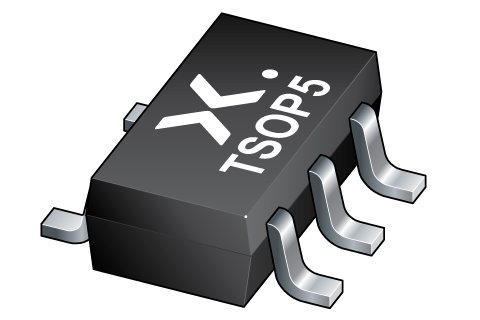Orderable parts
| Type number | Orderable part number | Ordering code (12NC) | Package | Buy from distributors |
|---|---|---|---|---|
| 74AHCT1G14GV-Q100 | 74AHCT1G14GV-Q100, | 935298661125 | SOT753 | Order product |

Register once, drag and drop ECAD models into your CAD tool and speed up your design.
Click here for more informationInverting Schmitt trigger
The 74AHC1G14-Q100 and 74AHCT1G14-Q100 are single inverters with Schmitt-trigger inputs. Inputs are overvoltage tolerant. This feature allows the use of these devices as translators in mixed voltage environments.
The AHC device has CMOS input switching levels and supply voltage range 2 V to 5.5 V.
The AHCT device has TTL input switching levels and supply voltage range 4.5 V to 5.5 V.
This product has been qualified to the Automotive Electronics Council (AEC) standard Q100 (Grade 1) and is suitable for use in automotive applications.
Automotive product qualification in accordance with AEC-Q100 (Grade 1)
Specified from -40 °C to +85 °C and from -40 °C to +125 °C
Wide supply voltage range from 2.0 V to 5.5 V
Overvoltage tolerant inputs to 5.5 V
CMOS low power dissipation
Symmetrical output impedance
High noise immunity
Latch-up performance exceesds 100 mA per JESD78 Class II Level A
ESD protection:
HBM: ANSI/ESDA/JEDEC JS-001 class 2 exceeds 2000 V
CDM: ANSI/ESDA/JEDEC JS-002 class C3 exceeds 1000 V
Wave and pulse shapers
Astable multivibrators
Monostable multivibrators
| Type number | VCC (V) | Logic switching levels | Output drive capability (mA) | fmax (MHz) | Nr of bits | Power dissipation considerations | Tamb (°C) | Rth(j-a) (K/W) | Ψth(j-top) (K/W) | Rth(j-c) (K/W) | Package name |
|---|---|---|---|---|---|---|---|---|---|---|---|
| 74AHCT1G14GV-Q100 | 4.5 - 5.5 | TTL | ± 8 | 60 | 1 | low | -40~125 | 282 | 70.5 | 177 | TSOP5 |
| Model Name | Description |
|---|---|
|
|
| Type number | Orderable part number, (Ordering code (12NC)) | Status | Marking | Package | Package information | Reflow-/Wave soldering | Packing |
|---|---|---|---|---|---|---|---|
| 74AHCT1G14GV-Q100 | 74AHCT1G14GV-Q100, (935298661125) |
Active | C14 |

TSOP5 (SOT753) |
SOT753 |
REFLOW_BG-BD-1
WAVE_BG-BD-1 |
SOT753_125 |
| Type number | Orderable part number | Chemical content | RoHS | RHF-indicator |
|---|---|---|---|---|
| 74AHCT1G14GV-Q100 | 74AHCT1G14GV-Q100, | 74AHCT1G14GV-Q100 |
|
|
| File name | Title | Type | Date |
|---|---|---|---|
| 74AHC_AHCT1G14_Q100 | Inverting Schmitt trigger | Data sheet | 2024-11-12 |
| AN11106 | Pin FMEA for AHC/AHCT family | Application note | 2019-01-09 |
| Nexperia_document_guide_MiniLogic_PicoGate_201901 | PicoGate leaded logic portfolio guide | Brochure | 2019-01-07 |
| SOT753 | 3D model for products with SOT753 package | Design support | 2019-01-22 |
| ahct1g14 | ahct1g14 IBIS model | IBIS model | 2013-04-08 |
| Nexperia_package_poster | Nexperia package poster | Leaflet | 2020-05-15 |
| SOT753 | plastic, surface-mounted package; 5 leads; 0.95 mm pitch; 2.9 mm x 1.5 mm x 1 mm body | Package information | 2022-05-31 |
| SOT753_125 | TSOP5; Reel pack for SMD, 7"; Q3/T4 product orientation | Packing information | 2020-04-21 |
| 74AHCT1G14GV-Q100_Nexperia_Product_Reliability | 74AHCT1G14GV-Q100 Nexperia Product Reliability | Quality document | 2025-03-20 |
| REFLOW_BG-BD-1 | Reflow soldering profile | Reflow soldering | 2021-04-06 |
| MAR_SOT753 | MAR_SOT753 Topmark | Top marking | 2013-06-03 |
| WAVE_BG-BD-1 | Wave soldering profile | Wave soldering | 2021-09-08 |
If you are in need of design/technical support, let us know and fill in the answer form we'll get back to you shortly.
The Nexperia Longevity Program is aimed to provide our customers information from time to time about the expected time that our products can be ordered. The NLP is reviewed and updated regularly by our Executive Management Team. View our longevity program here.
| Model Name | Description |
|---|---|
|
|
| Type number | Orderable part number | Ordering code (12NC) | Status | Packing | Packing Quantity | Buy online |
|---|---|---|---|---|---|---|
| 74AHCT1G14GV-Q100 | 74AHCT1G14GV-Q100, | 935298661125 | Active | SOT753_125 | 3,000 |
|
As a Nexperia customer you can order samples via our sales organization.
If you do not have a direct account with Nexperia our network of global and regional distributors is available and equipped to support you with Nexperia samples. Check out the list of official distributors.
The interactive datasheets are based on the Nexperia MOSFET precision electrothermal models. With our interactive datasheets you can simply specify your own conditions interactively. Start by changing the values of the conditions. You can do this by using the sliders in the condition fields. By dragging the sliders you will see how the MOSFET will perform at the new conditions set.